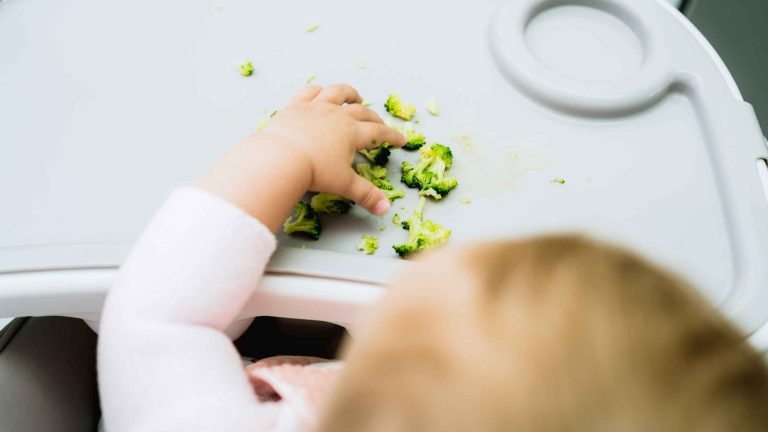
Baby Food Allergy: Symptoms and Treatment
- Created:
13. 12. 2022 - Updated:
12. 10. 2023
Does introducing food to baby fill you with a mixture of excitement and anxiety?
Baby food allergies are relatively common in children, and they can present themselves in several ways. Your feeding journey can become less stressful by recognizing the signs early and knowing what to do.
We have created a definitive guide covering everything you need to know. Common foods that trigger an allergic reaction, help you to identify an allergy with baby food allergy skin rash pictures.
What Is a Food Allergy?
A food allergy occurs when the body’s immune system mistakenly treats a particular food as an ‘invader’ and overreacts, releasing chemicals such as histamine. These chemicals can cause symptoms of an allergic reaction ranging from mild to severe. However, even if the initial response is mild, there is always a risk that it will be severe the next time.
Food allergies can range from a mild reaction to a potentially life-threatening one. Therefore, it is always crucial to know what to look out for when beginning the weaning process and introduce certain foods carefully.
The most common baby food allergy are:
- cow’s milk 🥛
- peanut 🥜
- egg 🥚
- fish 🐟
- soya 🌰
Family history can play a role in whether your child develops a food allergy.
If you, or someone else in your family, has a food allergy or another allergic condition. Such as asthma, hay fever, or eczema, research suggests. Your child has an elevated risk of having too.
Food allergies are common in babies and young children. Signs of baby food allergy usually occur within the first year of their lives. Although some children will outgrow these allergies by the age of 5 years, some will have them for life.
Types of Food Allergic Reactions – Mild, Moderate, and Severe
The symptoms are never predictable. And signs of a food allergy can show immediately after exposure to a food or up to a couple of hours after.
Mild to moderate food allergy symptoms can include:
- A food allergy rash, eczema flare or skin flushing. Most commonly, this appears in one area, often around the face.
- An itchy or runny nose.
- Congestion or cold-like symptoms.
- Sneezing.
- Vomiting.
- Swelling around the lips, eyes or face.
- Itchy, irritated eyes.
- Mild nausea or stomach discomfort.
- Mild coughing.
Severe food allergy symptoms can involve any of the following:
- A food allergy rash on several parts of the body.
- Swelling or tightness around the lips, tongue or throat.
- Difficulty swallowing.
- Difficulty breathing, wheezing, a tight chest or cough.
- Hoarse voice or cry.
- Consistent vomiting.
- Paleness.
- Fainting.
- Diarrhoea.
- Loss of consciousness or feeling floppy.
A severe reaction can very quickly lead to anaphylaxis (a quick and intense reaction) which is life-threatening.
If you spot a severe reaction, it is essential to act fast. Call an ambulance immediately and inject your child with an adrenaline pen, if you have been prescribed one.
Fortunately, these reactions are rare, but being aware of the signs will enable you to act quickly if you see them.
Sometimes allergic reactions are delayed, meaning they are far harder to spot. We often refer to these as delayed onset or non-IgE-medicated allergies. They affect different components of the immune system and are common in babies with a milk allergy.
Baby food allergy these symptoms can include:
- colic
- mucus or blood in the poo
- eczema
- red or itchy skin
What Does a Food Allergy Rash Look Like?
An allergy rash occurs when the body mistakes the food for being harmful and releases histamine into the bloodstream.
This causes:
The blood vessels widen, releasing fluids under the skin and creating inflammation.
So how do you spot a food allergy rash on a baby?
A food allergy rash on a baby often shows up quickly after eating a triggering food. The rash is usually tiny, itchy, raised bumps that are close together, generating what appears to look like a large rash.
These bumps are generally very small at a few millimeters wide, but they can be as large as a few inches wide.
These food allergy rash pictures will give you an idea of what to watch out for when feeding your baby.
Baby Food Allergy Rash on Belly
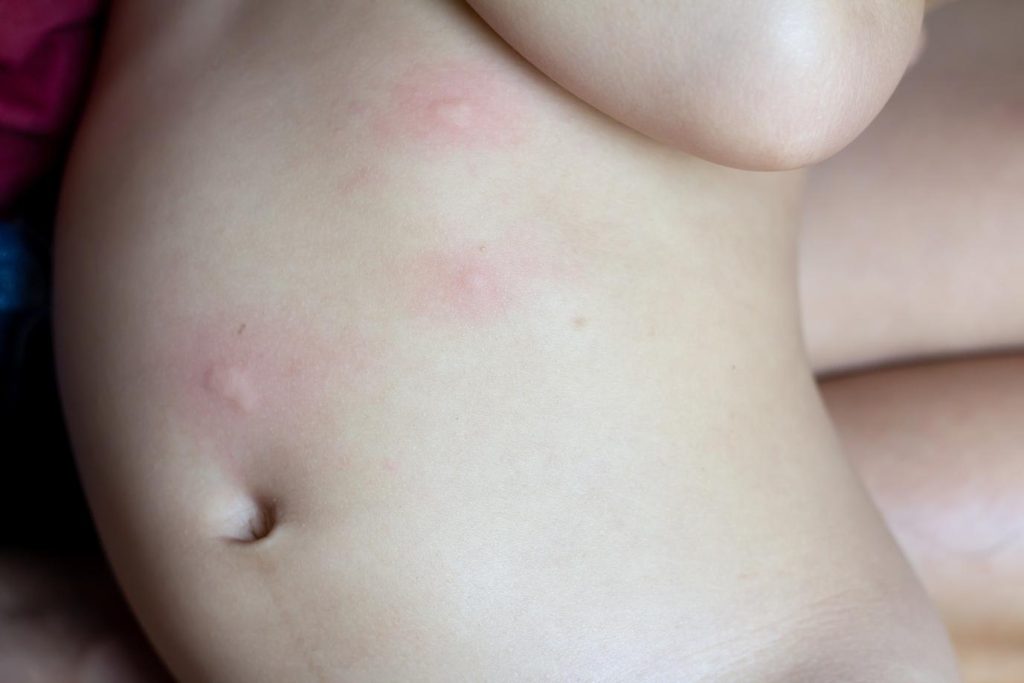
Hives appear as raised red or pink bumps and can appear as a swelling on the skin.
Baby Food Allergy Rash on Face
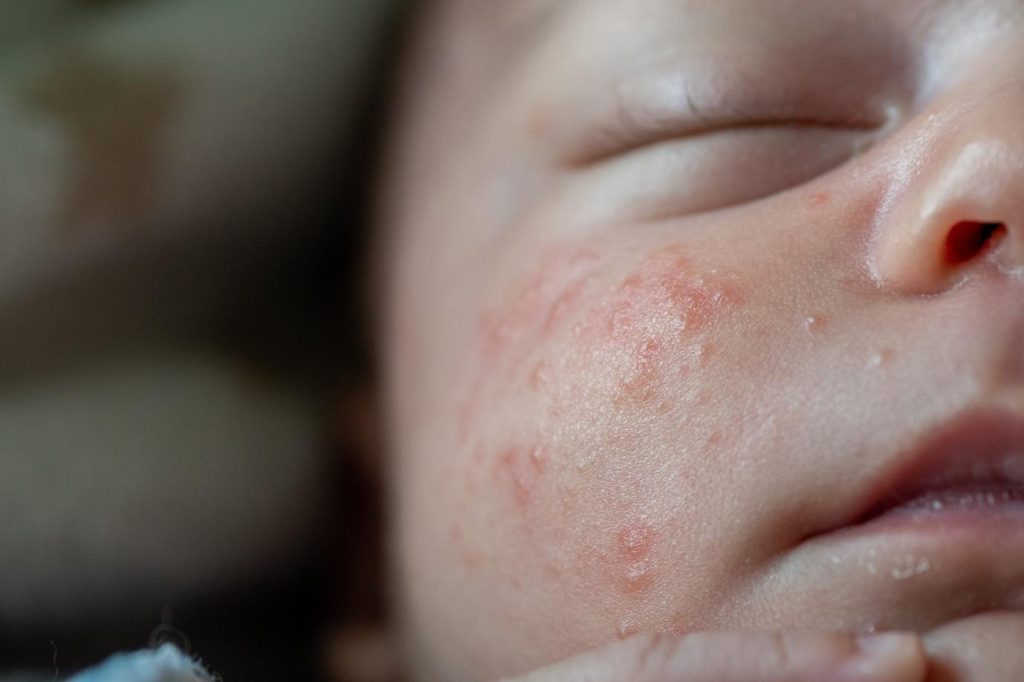
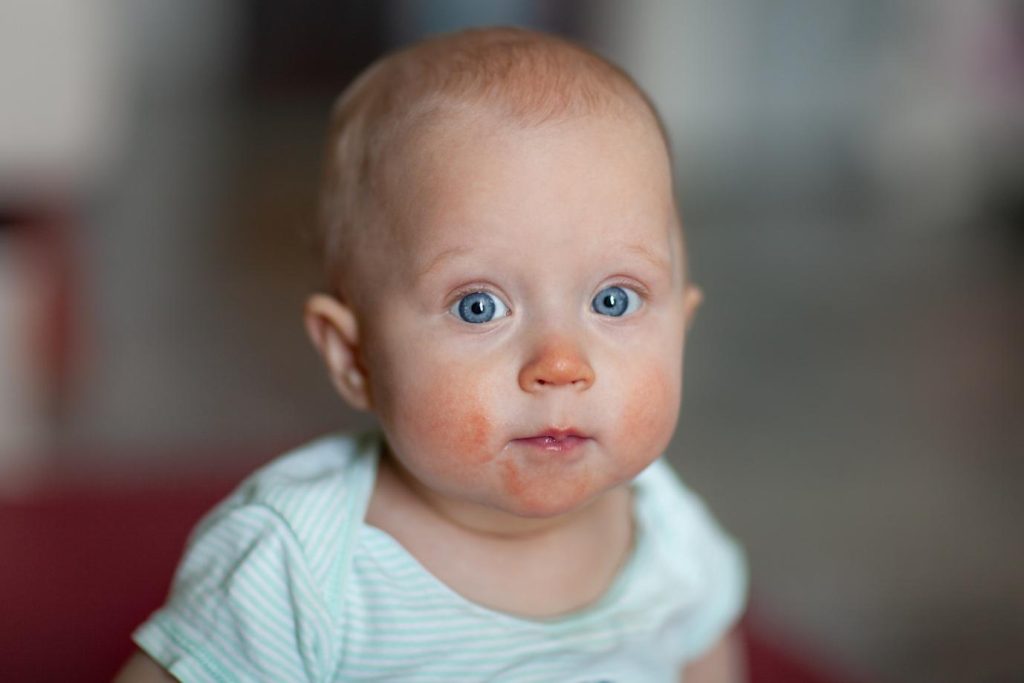
Eczema on Children
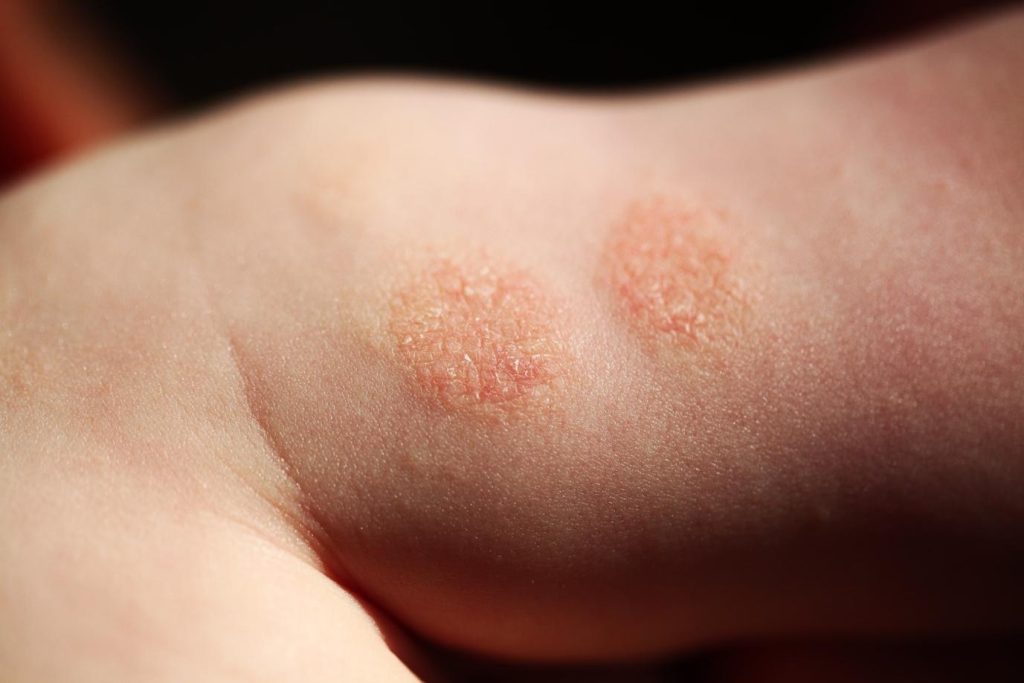
Another skin condition triggered by food allergy is eczema.
This rash may have tiny, red bumps or it will feel dry and itchy.
Usually, a food allergy can worsen symptoms of eczema. It is a common skin complaint, with 1 in 10 children currently diagnosed with eczema.
Foods That Can Trigger an Allergic Reaction
While any food can trigger an allergic reaction in a child. Certain foods are more likely to do so. The following foods are identified as the source of 90% of food allergies:
- Milk
- Eggs
- Peanuts
- Sesame
- Soy
- Wheat
- Fish
- Shellfish
- Tree nuts (such as cashews, almonds, and walnuts)
The most common allergies in babies under a year are peanuts, milk, and egg.
Whereas parents were once encouraged to avoid these foods during the weaning process, advice now states that avoiding these does not prevent an allergy and to introduce them early.
It is a good idea to introduce common allergen foods separately. Wait a few days before presenting another. So you can identify an allergy if there is one.
What to Do if You Suspect a Food Allergy?
If you spot any severe food allergy symptoms, you must call an ambulance immediately.
If you are concerned that your baby is showing mild to moderate symptoms of a food allergy, then stop giving the food and speak to your child’s health care provider.
Your healthcare provider may ask you the following questions:
- What are the signs and symptoms you have noticed?
- How long did it take the signs and symptoms to appear?
- How long did these symptoms last?
- Have these symptoms appeared every time your child has encountered the food allergen?
If your health care provider suspects a food allergy, then they may prescribe antihistamines, hydrocortisone creams, or an epinephrine pen – also known as an EpiPen.
A healthcare provider may also carry out skin testing and blood tests to confirm an allergy.
Although severe food allergies are rare, mild allergies are not. Therefore, be prepared and know what food allergy symptoms are, what a baby food allergy rash looks like, and essentially, how to react if your child exhibits signs of an allergy.
Baby Food Allergy Rash: How Long Does It Last?
Depending on the type of rash your baby has, it can take anything from a few hours to 2 weeks to subside.
Generally speaking, hives can disappear as quickly as a few minutes to a day or so. And eczema can take a few weeks to settle down after eliminating the food from the diet.
Final Tip: Protecting Your Baby with Annie Baby Monitor Food and Health Tracker
Have you heard about Annie Baby Monitor’s food and health tracker?
With this awesome feature, you can easily keep track of your baby’s food allergies and make sure they’re always safe and healthy.
It’s a total game-changer!
When introducing new foods to your baby, keeping track of what you’re feeding your child and how they react to it is a good idea.
To make things easier, you can use the health tracker to watch for any allergy symptoms like rashes, swelling, or digestive issues.
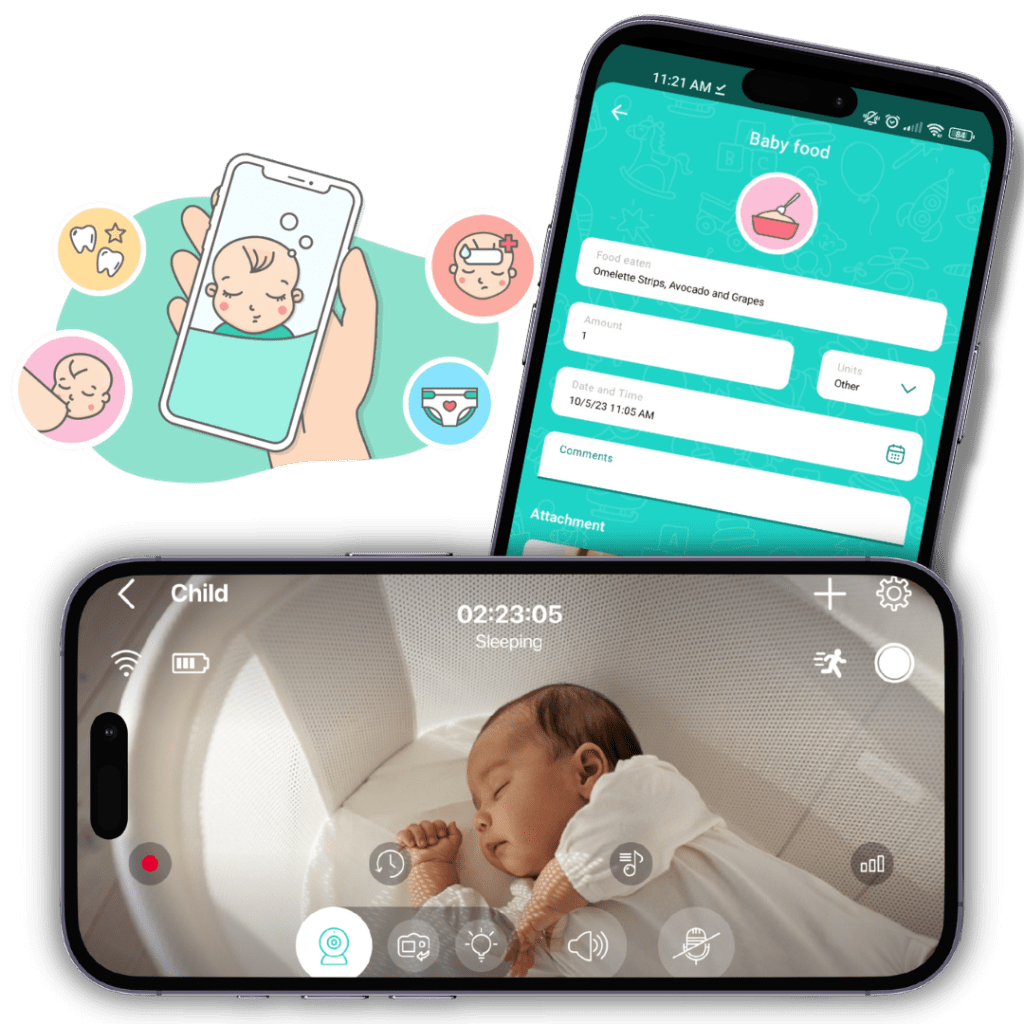
You can learn more about the Annie Baby Monitor tracker here.
Get the Annie Baby Monitor and become a feeding pro!This handy device makes organizing your baby’s feeding routine a breeze.
Breastfeeding a Baby With a Food Allergy
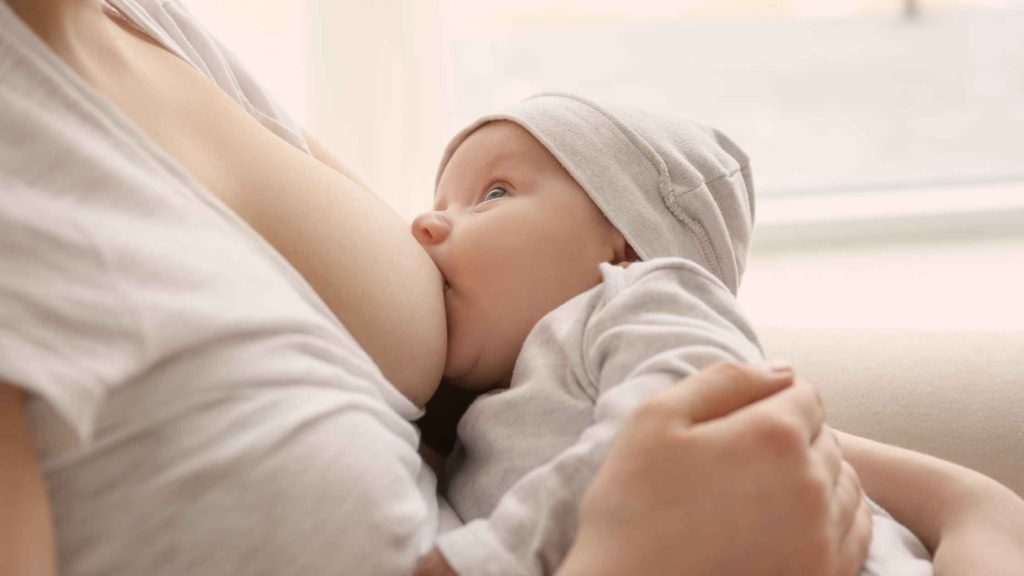
Babies who are breastfed can have a food allergy as the proteins in the food digested, appear in breast milk.
You may wonder if you can continue breastfeeding.
If your baby has shown signs of an allergy. Including developing a baby food allergy rash whilst breastfeeding. Then it is advised to avoid certain foods that cause your baby symptoms.
If you are finding this hard to pinpoint, start a food diary to keep track of your meals and note any allergic reactions.
It is always sensible to speak to a healthcare provider if you notice any changes in your baby after eating certain foods.
Baby Food Allergy FAQ: Answer to Common Questions
A food allergy rash can manifest in several ways. Most commonly, these itchy rashes will appear as hives or eczema. Hives appear as red, raised bumps or welts on the skin. Eczema is often red, dry and flaky.
The signs of a baby food allergy range from mild to severe. Mild symptoms include isolated skin rashes, mild stomach discomfort and congestion. More severe reactions are referred to as anaphylaxis and have life-threatening symptoms. Such as constriction and tightening of the airways, a rapid pulse and loss of consciousness.
Rashes can appear as quickly as a few seconds to as long as 48 hours after consuming a food allergen.
Food allergy skin rash looks like a raised, itchy red rash (hives). The skin may turn red and itchy without a raised rash in some cases. Swelling may occur anywhere in the body, such as the face, mouth (angioedema), throat, or other areas.
Hives tend to appear straight away and disappear quickly after a few hours or days. Worsening eczema can take several weeks to clear up.






